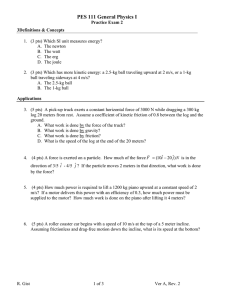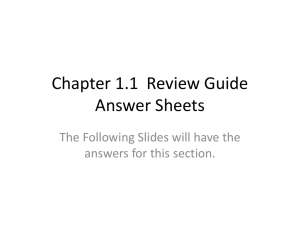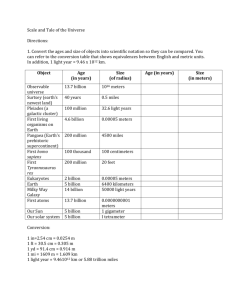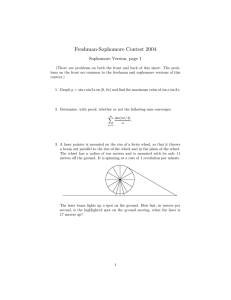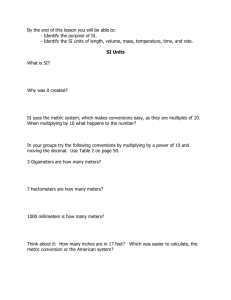PES 111 General Physics I
advertisement
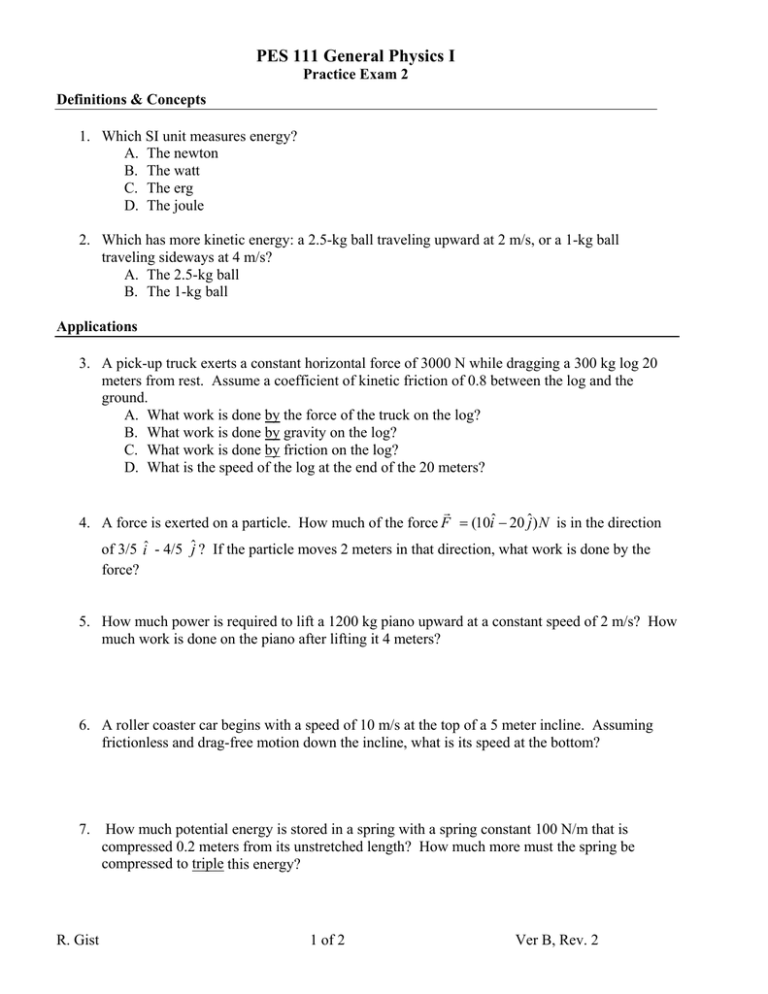
PES 111 General Physics I Practice Exam 2 Definitions & Concepts 1. Which SI unit measures energy? A. The newton B. The watt C. The erg D. The joule 2. Which has more kinetic energy: a 2.5-kg ball traveling upward at 2 m/s, or a 1-kg ball traveling sideways at 4 m/s? A. The 2.5-kg ball B. The 1-kg ball Applications 3. A pick-up truck exerts a constant horizontal force of 3000 N while dragging a 300 kg log 20 meters from rest. Assume a coefficient of kinetic friction of 0.8 between the log and the ground. A. What work is done by the force of the truck on the log? B. What work is done by gravity on the log? C. What work is done by friction on the log? D. What is the speed of the log at the end of the 20 meters? r 4. A force is exerted on a particle. How much of the force F = (10iˆ − 20 ˆj ) N is in the direction of 3/5 iˆ - 4/5 ĵ ? If the particle moves 2 meters in that direction, what work is done by the force? 5. How much power is required to lift a 1200 kg piano upward at a constant speed of 2 m/s? How much work is done on the piano after lifting it 4 meters? 6. A roller coaster car begins with a speed of 10 m/s at the top of a 5 meter incline. Assuming frictionless and drag-free motion down the incline, what is its speed at the bottom? 7. How much potential energy is stored in a spring with a spring constant 100 N/m that is compressed 0.2 meters from its unstretched length? How much more must the spring be compressed to triple this energy? R. Gist 1 of 2 Ver B, Rev. 2 PES 111 General Physics I Practice Exam 2 8. How much energy is gained or lost in forming a 3-He nucleus from two separate protons and a neutron? 9. Two air hockey pucks are traveling toward each other. Puck A has a mass of 0.6 kg and is moving at 2 m/s to the right. Puck B has a mass of 0.4 kg and is moving 2 m/s to the left. They collide head-on. The coefficient of elasticity of their collision is 0.8. How fast is puck A moving after the collision? 10. How many revolutions does a CD initially spinning at 6000 rpm go through if it is subjected to a constant deceleration and stops in 4 seconds? 11. What is the velocity of the center of mass of the following two particle system: m1=3 kg, r1=<-2, 0, 0> m, v1=<1, 0, 0> m/s m2=5 kg, r2=<-1, 1, 0> m, v2=<0,-2, 0> m/s 12. A 2000 kg car collides with a crash barrier and comes to a stop from its initial speed of 20 m/s in a time of 0.1 s. What average force is exerted by the barrier on the car? 13. A certain wheel is rotationally accelerated by firing two rockets on opposite edges of the wheel tangent to the wheel’s rim. The wheel has a radius 0.5 meters and a moment of inertia of 0.16 kg*m2. If the acceleration rate is 10 rad/s2, what is the magnitude of the tangent force due to the two rockets? 14. What is the total kinetic energy of a sphere rolling without slipping at 10 m/s? Its mass is 20 kg and its radius is 10 cm. How far up an incline of 10o will it travel before stopping? 15. Alfred is travelling on a spaceship toward Proxima Ophiuchi at half the speed of light when he passes Barnard, who is sitting on his home planet (at rest with respect to the stars). Barnard has measured the distance to Proxima Ophiuchi as 6 light years in his reference frame. How far does the star appear to be in Alfred’s reference frame? What time interval does Alfred measure to travel this distance? What time interval does Barnard measure for Alfred to travel to the star? R. Gist 2 of 2 Ver B, Rev. 2
